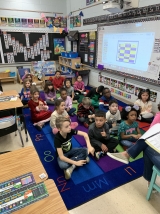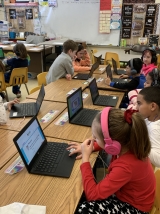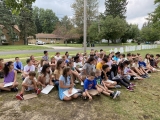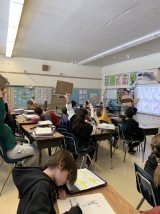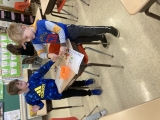-
Category 1
Selected in 2023
-
Grades: k - 4
School Setting: suburban
Town Population: 81,000
Student Enrollment: 460
Student Demographics:
Black/African American: 7%
Teacher/Student Ratio: 1:21
White/Caucasian: 59%
Hispanic: 17%
Hawaiian/Pacific Islander: 2.5%
Asian: 7%
Native American: 2.5%
Other: 5%
% Reduced Lunch: 49%
% ELL Learners: 15%
Founded: 1957 -
PRINCIPAL:
Renee Dzurnak -
CONTACT:
3600 Dentzler Road
Parma, OH 44134
440-885-2426
dzurnakr@parmacityschools.org
Dentzler Elementary School
Parma, OH
"The greatest contributing factor that promotes positive change in our school is staff collaboration and consistency."
- 1. Tell us about your school’s success.
-
The key strategies that have had a positive impact on our student achievement over time includes: Consistent analysis of data, small group instruction and interventions, and collaboration among staff.
All students begin the year with benchmark testing to assess their present level of performance. This benchmark score, along with other student data, is analyzed and used to group students according to need. We come together as a staff and participate in a program called Data Day, where we spend time analyzing student data, looking at previous data, and working to understand each student as an individual learner. Students are then placed in PIE (prevention, intervention, enrichment) groups and instructed daily in the specific areas of reading (phonemic awareness, phonics,vocabulary, reading fluency, and reading comprehension). Consistent instruction in these early foundational skills build high levels of reading and writing proficiency overtime. Our Title I and general education staff have been trained in the Science of Reading and our curriculum is aligned to this strategy. In addition, Regular progress monitoring of students allows staff to adjust the plan and change the small intervention groups as needed. Flexible grouping provides many opportunities for students to progress and move on to the next instructional group. The collaboration among all staff, Title staff, intervention specialists, and classroom teachers allows us to sustain this effort and continue the trend of exceptional student performance. Everyone believes that all students can learn and we provide a multi-sensory approach to accomplish this goal. In addition to PIE instruction, title I staff provide extra support time within the k-2 general education classrooms daily. This additional time allows for more small group instruction, tutoring, and one on one instruction for students who need more direct instruction. We regularly set goals with students and work with them to understand their goal and track progress toward the goals. We have maintained this effort for years, and new staff coming into the building are trained, supported, and acclimated to the Dentzler way of consistent rigorous daily instruction. - 2. Talk about the greatest contributing factor(s) that promoted positive change in your school.
- The greatest contributing factor that promotes positive change in our school is staff collaboration and consistency. Various school teams work together consistently on instructional and intervention strategies that are research based. These strategies are implemented with fidelity to meet students at their instructional level and increase student achievement.
- 3. How has ESEA funding supported the school's success?
-
Our comprehensive and rigorous programs have focused our efforts to support students at risk of not meeting state standards. We implement small intervention groups several times daily at all grade levels to instruct and support students at their specific instructional level. By doing this, students learn basic foundational skills, receive more adult attention and teaching, and learn more quickly which closes their educational gap. Our staff is highly trained in the Science of Reading, LETRS, and sound wall training. These strategies recognizes that each student has individual needs and abilities. By understanding the five components of the Science of Reading, teachers can better equip their students to move from initial recognition to proficient comprehension. Our teachers use these research-based methods to assess where students fall in their reading level and provide them with instruction in the next step in the process of learning to read.
Our teachers have learned how to effectively respond to the variety of needs of English learners, students with disabilities, and those with dyslexia tendencies. Every student has unique needs that require an individualized approach for successful learning outcomes. In addition to highly trained staff, we collaborate weekly at Teacher based team meetings to review student progress and data, and make adjustments to instruction at each grade level. We use Title I funds to implement the Book of the year program and Family Engagement Activities which encourage family literacy and families reading together. We encourage and support an overall school culture of literacy and target groups that need additional tutoring in order to be successful on classroom and state assessments. This tutoring program gives our students an extra edge to reach high levels of achievement and close the learning gaps for groups of students. We are proud of our accomplishments in the area of academic achievement with our students and their continued educational success. - 4. What professional development activities were used to improve teaching and learning?
- Our staff have been involved in a variety of professional development activities ranging from LETRS, IXL, district, and building led activities that allow for collaboration and additional learning that positively impacts our students.
- 5. Talk about the cultural shift leading up to your school's success.
- The building culture and philosophy is one of "all hands on deck". Teacher teams including EL, Building Literacy Specialist, Title I staff and intervention specialists work together and collaborate on instructional practices and meeting students' needs. Teacher based teams meet weekly to collaborate and plan instructional strategies based on student data. Data drives instruction and the team analyzes data consistently. We believe that all students can learn and collaboration, communication, and accountability are the keys to school success.
- 6. How has community involvement strengthened your success?
- The support of our community and local PTA have strengthened our school success by providing additional programs and funds. Our community provides field trips and educational opportunities outside of the school setting, they promote your school programming, and celebrate our success publicly. This collaboration keeps a focused vision on our school success.
Stats
-
Category 1
Selected in 2023
-
Grades: k - 4
School Setting: suburban
Town Population: 81,000
Student Enrollment: 460
Student Demographics:
Black/African American: 7%
Teacher/Student Ratio: 1:21
White/Caucasian: 59%
Hispanic: 17%
Hawaiian/Pacific Islander: 2.5%
Asian: 7%
Native American: 2.5%
Other: 5%
% Reduced Lunch: 49%
% ELL Learners: 15%
Founded: 1957 -
PRINCIPAL:
Renee Dzurnak -
CONTACT:
3600 Dentzler Road
Parma, OH 44134
440-885-2426
dzurnakr@parmacityschools.org



